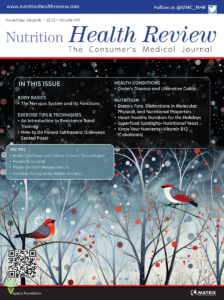 As we age, our bodies gradually begin to lose bone mass, putting us at risk for osteopenia and osteoporosis. These are diseases in which bone mineral density, which determines the strength of a bone and the risk that it might break, is abnormally low.1 A dual-energy x-ray absorptiometry (DXA) scan measures and classifies bone density into three categories: normal, osteopenia, and osteoporosis. A T-score ranging from –1 to –2.5 indicates osteopenia, and any score –2.5 or lower indicates osteoporosis.1 Low bone density increases the risk for fractures, loss of height, and limited mobility. The bones most vulnerable to fracture are the hips, spine, and wrist, and hip fractures are associated with a higher risk of death within the year of the hip fracture.2,6
As we age, our bodies gradually begin to lose bone mass, putting us at risk for osteopenia and osteoporosis. These are diseases in which bone mineral density, which determines the strength of a bone and the risk that it might break, is abnormally low.1 A dual-energy x-ray absorptiometry (DXA) scan measures and classifies bone density into three categories: normal, osteopenia, and osteoporosis. A T-score ranging from –1 to –2.5 indicates osteopenia, and any score –2.5 or lower indicates osteoporosis.1 Low bone density increases the risk for fractures, loss of height, and limited mobility. The bones most vulnerable to fracture are the hips, spine, and wrist, and hip fractures are associated with a higher risk of death within the year of the hip fracture.2,6
Risk Factors
Older people, female biological sex, people experiencing menopause, and people with a low body weight are at higher risk for developing osteopenia and osteoporosis than other groups. Medical conditions that put people at risk include autoimmune disorders (e.g., rheumatoid arthritis, lupus), digestive and gastrointestinal disorders (e.g., inflammatory bowel disease, celiac disease), endocrine/hormonal disorders (e.g., hyperthyroidism, diabetes), hematologic/blood disorders (e.g., leukemia, lymphoma), and eating disorders (e.g., anorexia nervosa).3
Prevention
Calcium and vitamin D. Lifestyle habits, including good nutrition, can help reduce the risk of developing osteopenia or osteoporosis. A major contributor to loss of bone density is insufficient intake of calcium and vitamin D. Ninety-nine percent of calcium in the body is stored in the bones. When too little calcium is consumed, the body will take calcium from its bones to support other bodily functions and systems that require calcium, thus weakening the bones.4,5 Increasing vitamin D consumption alongside calcium is crucial, as calcium alone has not been shown to reduce fractures.5 The National Osteoporosis Foundation recommends people age 50 years or younger intake 1,000mg of calcium and 400 to 800IU of vitamin D per day, men age 50 to 70 years should consume 1,000mg of calcium and 800 to 1000IU of vitamin D per day, and women age 51 years or older and men age 71 years or older should consume 1,200mg of calcium and 800 to 1000 IU of vitamin D per day.3
Sources of vitamin D include sunlight exposure, egg yolks, fatty fish (e.g., wild-caught salmon, tuna), and fortified foods (e.g., cereal, dairy products, orange juice). Since it can be difficult to receive enough vitamin D from sunlight and food alone, supplements are an effective means to improve bone health.4,5
Calcium sources include dairy products (e.g., milk, cheese, yogurt), dark leafy greens (e.g., collard, kale, broccoli), canned salmon and sardines, and fortified foods (e.g., soy or almond milk, orange juice, tofu, cereal).4,6 Calcium supplements, though helpful, should not be relied upon as the sole or primary source for the nutrient, due to the risk of overconsumption. Consuming too much calcium can result in kidney stones constipation, and other health conditions.6 However, people who are lactose intolerant, follow a vegan diet, or cannot receive sufficient calcium in their diet for any reason should consider taking a calcium supplement under a physician’s advice. Supplements should be taken in amounts of 500 to 600mg or less; the body has difficulty absorbing higher amounts. Most supplements should be taken with food to allow for optimal calcium absorption; calcium citrate does not need to be taken with food.4,6
Exercise. Another important preventative measure is participating in weight-bearing and muscle-strengthening exercises for 30 to 40 minutes a day. Adolescents who are active reach a higher bone mass than those who are not. Weight-bearing exercises aid in slowing bone loss related to disuse, improving balance, increasing muscle strength, and reducing fall risk in older adults.7 Examples of weight-bearing and muscle-strengthening exercises include walking, running, dancing, jumping rope, tennis, stair climbing, lifting weights and using weight machines, and using elastic resistance bands.8
Alcohol and smoking. Excessive intake of alcohol is correlated with low bone mineral density, and it interferes with the body’s calcium supply.3,9 Although the exact amount of daily alcohol consumption considered harmful is unclear,5 in general, it is recommended to limit alcohol intake to 1 to 3 drinks per day.3,5 There is also a correlation between smoking and lower bone density due to its inference in our body’s absorption of calcium into its bones. Also, people who smoke tend to have earlier onset menopause, which increases the risk of osteoporosis.9
Medication
Antiresorptive agents act as a pharmacologic treatment for osteoporosis. These medications are designed to decrease bone resorption and, in some cases, prevent fractures. Medications include bisphosphonates and selective estrogen modulators.7
Bottom Line
Adopting preventative measures, such as consuming the daily recommended values of calcium and vitamin D and partaking in weight-bearing exercise each day, should be a priority for all people, especially those at a higher risk for developing osteopenia and osteoporosis. People should moderate their alcohol intake and refrain from smoking as well. Osteopenia and osteoporosis cannot be cured, but taking the proper precautions can prevent the disease and increase quality of life.
Sources
1. Harvard Health website. Osteopenia: when you have weak bones, but not osteoporosis. 6 Jul 2020. https://www.health.harvard.edu/womens-health/osteopenia-when-you-have-weak-bones-but-not-osteoporosis. Accessed 17 Aug 2021.
2. National Osteoporosis Foundation website. What is osteoporosis and what causes it? https://www.nof.org/patients/what-is-osteoporosis/. Accessed 17 Aug 2021.
3. National Osteoporosis Foundation. Who gets osteoporosis: factors that put you at risk. https://cdn.nof.org/wp-content/uploads/2016/02/Who-Gets-Osteoporosis.pdf. Accessed 17 Aug 2021.
4. National Osteoporosis Foundation website. Calcium and vitamin D. https://www.nof.org/patients/treatment/calciumvitamin-d/. Accessed 17 Aug 2021.
5. Kling JM, Clarke BL, Sandhu NP. Osteoporosis prevention, screening, and treatment: a review. J Womens Health (Larchmt). 2014;23(7):
563–572.
6. Cleveland Clinic website. Osteoporosis: prevention with calcium treatment. Reviewed 29 Nov 2020. https://my.clevelandclinic.org/health/articles/15049-osteoporosis-prevention-with-calcium-treatment. Accessed 17 Aug 2021.
7. Sözen T, Özışık L, Başaran NÇ. An overview and management of osteoporosis. Eur J Rheumatol. 2017;4(1):46–56.
8. National Osteoporosis Foundation website. Osteoporosis exercise for strong bones. https://www.nof.org/patients/treatment/exercisesafe-movement/osteoporosis-exercise-for-strong-bones/. Accessed 17 Aug 2021.
9. National Institutes of Health website. Smoking and bone health. Reviewed Dec 2018. https://www.bones.nih.gov/health-info/bone/osteoporosis/conditions-behaviors/bone-smoking. Accessed 17 Aug 2021.





